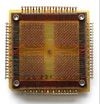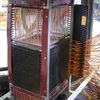1953: Whirlwind computer debuts core memory
Magnetic cores provide a fast, reliable solution for computer main memory




A magnetic core memory stores information on arrays of small rings of magnetized ferrite material called cores. Each core stores one bit of data that may be switched from a ONE to a ZERO by changing the polarity of the induced magnetic field. Electrical pulses in wires threaded through the array both detect (read) and change the direction (write) of magnetization of a specific core. High speed, improved reliability, random access to any bit of information, and non-volatile storage encouraged the rapid acceptance of core as the preferred technology for computer main memory in the early 1950s.
Amateur inventor Frederick W. Viehe filed a core memory patent in 1947 followed by Harvard physicist An Wang in 1949. RCA’s Jan Rajchman and MIT’s Jay Forrester filed in 1950 and 1951 respectively. Other important contributors include E. Albers-Schönberg, J. P. Eckert, and M. K. Haynes. Led by Forrester, the Whirlwind computer project at Massachusetts Institute of Technology for a U.S. Navy real-time flight simulator replaced a troubled electrostatic CRT memory with a 32 by 32 array (called a plane) of 1024 cores and demonstrated its advantages for the first time in August 1953.
Announced in 1954, the first IBM commercial core unit, Model 737, offered 4,096 36-bit words for a rental fee of $6,100 a month. Ten years later the Control Data Corporation CDC6600 supercomputer offered up to 2 million 60-bit words of extended core storage. A labor intensive task, the assembly of core memory planes became one of the first U.S. electronic manufacturing operations to move to Asian plants. Cost declined from $1.00 to one cent per bit before being replaced by semiconductor memory in the 1970s
Contemporary Documents
- Viehe Frederick W. “Electronic relay circuit” U.S. Patent 2970291 (Filed: May 29. 1947 Issued: Jan 31, 1961)
- Wang, An. "Pulse transfer controlling devices" U.S. Patent 2708722 (Filed: October 1949 Issued: May 1955)
- Forrester, Jay. “Multicoordinate digital information storage device" U.S. Patent 2736880 (Filed: May 1951 Issued: February 28, 1956)
- Forrester, Jay W. "Digital Information Storage in Three Dimensions Using Magnetic Cores" J. Applied Physics (Vol. 22, No. 1, 1951) pp. 44-48
- Rajchman, J. A. “Static Magnetic Matrix Memory and Switching Circuits” RCA Review (Vol. XIlI No. 2, June 1952)
More Information
- "Whirlwind: Preparing the Way for SAGE" Revolution Exhibit Computer history Museum
- Pugh, Emerson W. “Ferrite core memories that shaped an industry” IEEE Transactions on Magnetics, (Vol. 20 No. 5, Sept. 1984) pp. 1499 - 1502
- “Magnetic Core Memory Systems” (Retrieved on 8.8.15 from: http://www.cs.ubc.ca/~hilpert/e/coremem/index.html)
- Redmond, Kent C. and Thomas M. Smith, Project Whirlwind: The History of a Pioneer Computer Digital Press (DEC) (1980)
Oral Histories
- "Reichard, Bob (Robert) oral history" Computer History Museum Oral History # 102658045 (2005-10-27)
- "Rajchman, Dr. Jan An oral history conducted in 1975 by Mark Heyer and Al Pinksy" IEEE History Center, Hoboken, NJ, USA
- "Forrester, Jay W. Oral History Transcript of a Video History Interview" MIT, Sloan School of Management (March 24, 1998)
- “An Wang interviewed by Richard Mertz” Computer Oral History Collection, National Museum of American History (October 29, 1970) [Retrieved on 8.2.15 from: http://amhistory.si.edu/archives/AC0196_wang701029.pdf]
File name: 1953_Core_v2
Rev 11.5.15


